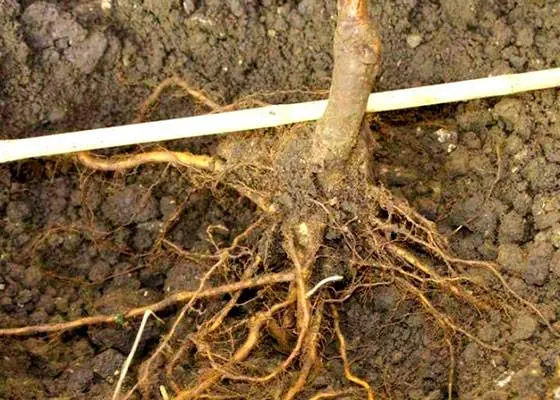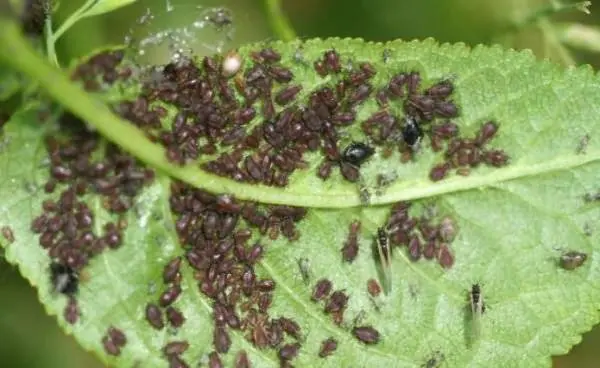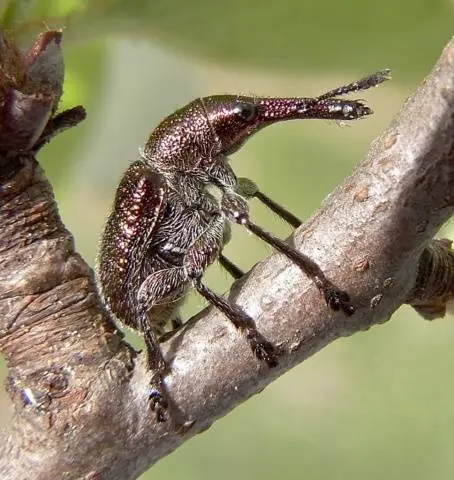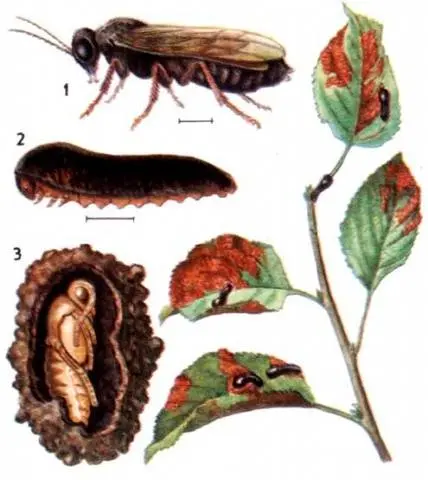Contents
Growing cherries in recent decades has been very difficult. And the point here is not that this is a capricious culture. Fungal diseases destroy many trees, nullifying all the efforts of gardeners to obtain a crop. Therefore, cherry varieties that have at least relative resistance to them are so valuable. One of them is the self-fertile cherry Zagorievskaya.

History of breeding
Cherry Zagoryevskaya was created by employees of the All- Selection Technological Institute of Horticulture and Nursery. It is located in Biryulyovo on the site where the village of Zagorye used to be. Hence the name cherry. The parents were Lyubskaya and Consumer goods black. Variety Zagoryevskaya was specially created for cultivation in the climatic conditions of the northwestern part of Our Country. The variety is not included in the State Register, which does not prevent gardeners from successfully growing it.
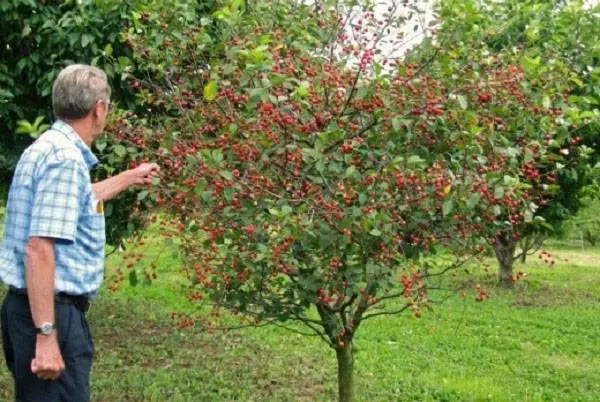
Description of the culture
Variety Zagoryevskaya belongs to the ordinary cherry. This is a medium sized tree. Its maximum height can reach 3,5 m. The dense crown of the cherry is sprawling, often has a rounded shape. It is not too thick, which is good: there is less risk of fungal diseases.
The fruits of this variety of cherries are more reminiscent of cherries in color and appearance. Each berry can weigh up to 4,4 g – a lot for a cherry. Dark cherry rounded berries of the Zagoryevskaya cherry have a slight brown tint in color. The pulp is dense, ocher color. The taste of this cherry is traditional, sweetish with obvious sourness and chocolate flavor. A small bone is easily separated from the pulp. The cherries themselves come off the stem with some effort.
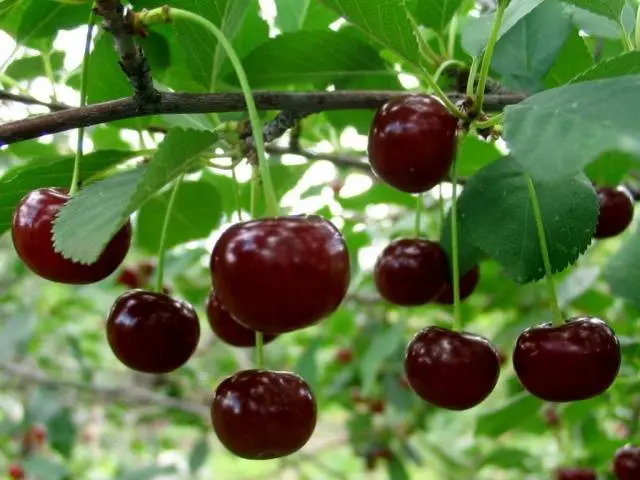
Features
The characteristic of the Zagoryevskaya cherry variety is important for those gardeners who are just about to plant this tree. We will try to answer all questions that may arise.
Drought resistance, winter resistance
The Zagoryevskaya cherry is quite resistant to drought, therefore it can be successfully grown in the southern regions. But it does not tolerate stagnant water, so it is not planted in the lowlands, the groundwater level should not be high either.
According to the originators of the variety, the frost resistance of Zagoryevskaya cherries is average. But in severe frosts, it is not the shoots that freeze, but the flower buds. For cherries of the Zagoryevskaya variety, the root system also needs preventive shelter from frost: it is advisable to mulch the near-trunk circle for the winter with humus or any other organic matter with a layer of up to 15 cm. Return frosts can also harm blooming flowers. In this case, the yield will be minimal.
Therefore, with a sharp drop in temperature to 0 and below during flowering, measures must be taken:
- carry out sprinkling;
- arrange smoke;
- or just cover the tree with spunbond, the low growth of the shrub allows this to be done.
All these measures will help to save the harvest.
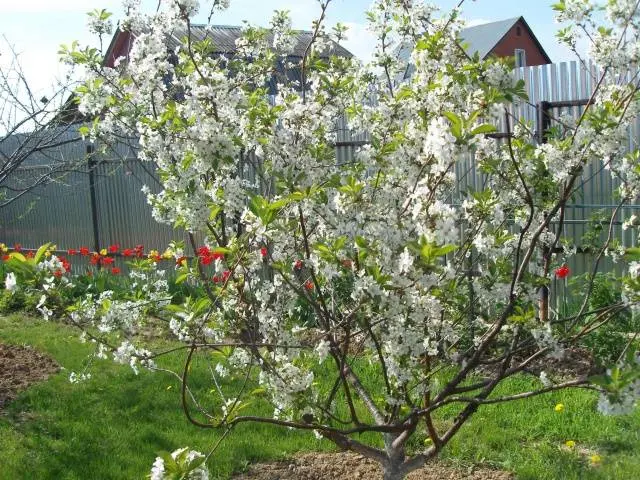
Pollination, flowering period and ripening period
Unlike many other cherries that do not produce crops without a pollinator nearby, the self-fertile variety of Zagoryevskaya cherries endows with a large number of berries without them. This tree will provide the gardener with a large harvest, even if it is in the garden in the singular.
For Zagoryevskaya cherries, these are Shubinka, Lyubskaya, Vladimirskaya.
They, like Zagoryevskaya, bloom at the end of May. The berries of this variety of cherries ripen in medium terms. Depending on the weather, this is the end of July or the beginning of August.
yield, fruiting
Starting fruiting early – in the third or fourth year, the Zagoryevskaya cherry quickly increases its yield. An adult tree is quite capable of producing up to 13 kg of cherries. This is one of the best indicators among all varieties with such a small habit.
Scope of berries
A high tasting score of 4,5 points characterizes this variety as a dessert variety. Jams, preserves, compote and cherry liqueur are excellent from its berries.
Disease and pest resistance
Our Country has long been famous for its cherry orchards. But the mutation of pathogens of fungal diseases led to the formation of new aggressive races. The existence of cherries in Our Country was threatened. It cannot be said that the Zagoryevskaya cherry is completely resistant to this scourge. It is moderately affected by coccomycosis and moniliosis. But the use of preventive treatments with fungicides will allow you not to worry about this.
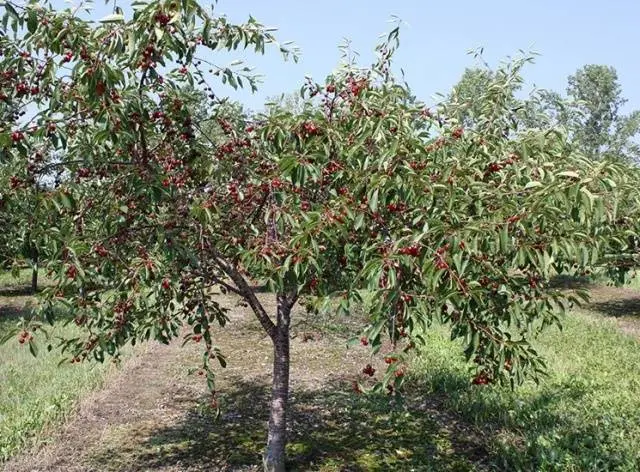
Advantages and disadvantages
For convenience, we summarize them in a table.
Advantages | Disadvantages |
Small size – easy to pick berries | sour fruits |
Good frost resistance | Medium resistance to fungal diseases |
High commercial quality of fruits | Freezing of flower buds during spring frosts |
Drought tolerance |
|
Great yield |
|
Self-fertility |
|
Skoroplodnost |
|
Features of landing
Like any other crop, cherries have their own planting characteristics that must be taken into account in order for the tree to grow well and bear fruit.
Recommended dates
They depend on the region in which they are going to plant Zagoryevskaya cherries:
- in the southern regions it is autumn;
- in the middle lane can be planted in spring and autumn;
- where the climate is harsh, planting is transferred to spring.
When planting in the autumn, one should not forget that a young seedling of Zagoryevskaya cherry needs a frost-free period for rooting.
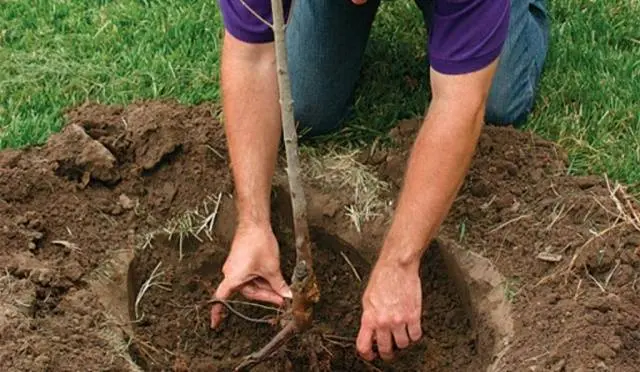
Choosing the right place
Cherry is a light-loving plant, its habitat should be lit throughout the day. For her to be comfortable, the following conditions must be met:
- pick up a site where meltwater does not stagnate in spring, and ground waters are low (no higher than 2 m);
- air circulation should be free, but without strong northerly winds;
- soils are preferably light in mechanical composition – sandy loam or loam, with a high content of humus;
- the optimal soil reaction is from 5,5 to 7,0.
Do not plant Zagoryevskaya cherries on peat bogs or areas with a predominance of clay.
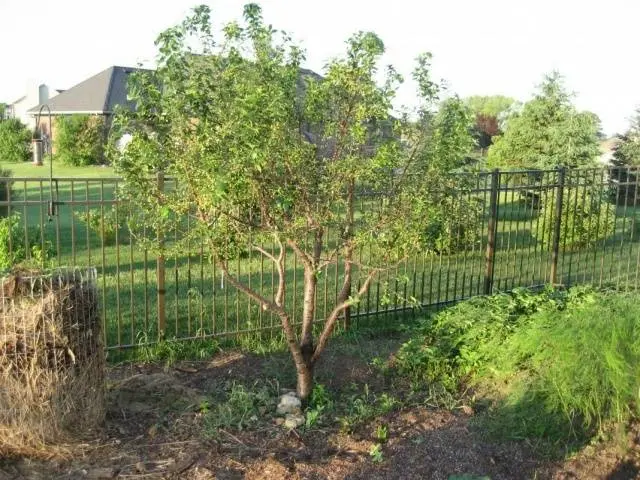
What crops can and cannot be planted next to cherries
The common cherry belongs to the extensive rose family, which includes apple, raspberry and many other fruit trees and shrubs. All of them are prone to fungal attack. Therefore, neighbors from this family are undesirable for cherries. You should not plant Zagoryevskaya next to tall fruit trees with a developed root system. A small cherry tree simply will not survive next to them, competing for food and moisture.
Selection and preparation of planting material
The most win-win option is to buy a Zagoryevskaya cherry seedling with a closed root system. It is guaranteed to take root and you can plant it during the entire growing season. But they are expensive and not always easy to find.
Therefore, let’s pay attention to the criteria for choosing a Zagoryevskaya cherry tree with open roots:
- it must be a one-year-old or two-year-old;
- the root system is developed, not overdried and without signs of rot;
- the trunk and branches are not damaged and not dried.
Such a procedure will not be superfluous for any Zagoryevskaya cherry tree with an open root system.
Landing algorithm
We prepare a landing pit for cherries in advance, optimally – in the season preceding planting. The action algorithm is as follows:
- we dig up the soil at the planting site, choosing the roots of weeds;
- we dig a hole 50×80 cm. We set aside the top layer of soil with a depth of a shovel bayonet separately – we will mix it with fertilizers – 500 g of superphosphate and wood ash, 90 g of potassium sulfate, and organic matter – two buckets of humus.
- we install a peg for tying a seedling of Zagoryevskaya cherry;
- we pour a mound from the prepared planting mixture, place a tree of Zagoryevskaya cherries on it – the roots should be straightened;
- we fill the roots with the rest of the planting mixture so that the root neck remains at the level of the soil;

- slightly trample the soil;
- pour a bucket or 2 water into the trunk circle;
- we mulch and tie a seedling of Zagoryevskaya cherry to a peg;
- we shorten the branches in order to balance the underground and above-ground parts damaged during transplantation.
After planting, the young tree requires regular watering until rooting.
Culture aftercare
Subsequent care consists of top dressing, watering, crown formation.
Feeding
As a rule, in the first year after planting, the plant does not need to be fed.
Starting next spring, nitrogen fertilizers are applied according to the norms on the package, but in two steps: half before flowering, the rest 2 weeks after it. During the pouring, the berries are fed with a complete mineral fertilizer. In September, potash and phosphorus fertilizers are applied, which contributes to a better preparation of the Zagoryevskaya cherry for winter.
Watering
Cherry Zagoryevskaya most of all needs watering at the time of pouring berries and during a long drought. Usually spend one or two buckets per tree. After leaf fall, it is necessary to carry out water-charging watering of the near-stem circle, which is especially important in dry autumn.
Trimming
The formation of the crown begins immediately after planting, when the shoots are shortened by a third of their length. Sanitary pruning is carried out in early spring. Cherry Zagoryevskaya does not suffer from crown thickening, but every few years you need to remove the branches growing inside the bush.
Learn more about video cropping:
The trunk circle is kept clean from weeds. Once every 5 years, the soil under the cherry is limed.
Preparation for winter
About autumn top dressing and water-charging watering has already been written above. For better preservation of the root system in frosts, the trunk circle for the winter is mulched with peat or humus. The trunks are whitewashed with lime mortar, to which a fungicide is added. This measure will protect the tree from burns in early spring and from damage to the trunk by fungi. Young cherries of the Zagoryevskaya variety can be wrapped with spunbond for the winter. In the future, the lower part of the trunk must be protected from mice and hares by wrapping it with a net.
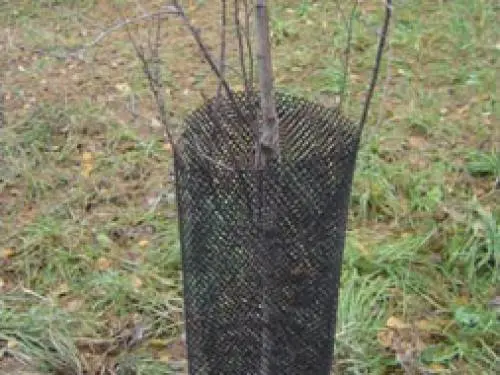
Diseases and pests, methods of control and prevention
The main scourge of all cherries is fungal diseases. Zagoryevskaya is moderately resistant to them. But in a wet year, defeat is very likely. What is sick cherry Zagoryevskaya:
Disease | As manifested | Treatment | Prevention |
Moniliasis | The twigs seem to be burned, the leaves dry on them | Cut out all damaged parts of the plant, capturing up to 10 cm of healthy tissue, treat with fungicides: Cineb, Kuprozan, Ftalan | In autumn, all fallen leaves and mummified fruits remaining on the tree are removed. In the spring, preventive spraying with copper-containing fungicides is carried out before bud break. |
Kokkomikoz | Brownish-red dots on the leaves, from the inside a plaque of spores of the fungus, which has a white-pink color. Leaves fall prematurely. The fruits are mummified | Removal of diseased parts of the plant, treatment with Topaz, Skor, Chorus or Fundazol Removal of diseased parts of the plant, treatment with Topaz, Skor, Horus or Fundazol | Triple treatment with Bordeaux liquid, Topsin-M or Skor: on a green cone, after flowering and in autumn |
Antraknoz | Pinkish coating on fruits, which are then mummified | Triple treatment with Polyram: before flowering, after it and 2 weeks later | Collection and destruction of diseased fetuses |
Comedy | Transparent drops of gum stand out from the cracks on the trunk | Cover wounds with garden pitch | Whitewashing the trunks in the fall and processing them with copper sulphate |
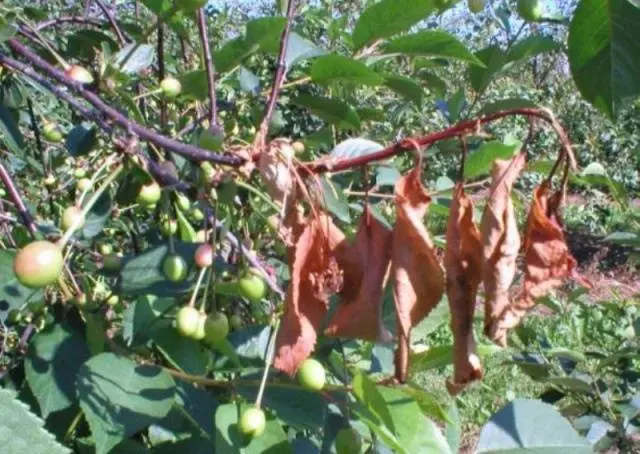
The following pests can attack the Zagoryevskaya cherry:
- cherry aphid, they fight it with the help of Iskra or Inta-Vira;

- cherry weevil damages the buds of flowers and ovaries, helps Intavir, Kinmiks or Karbofos;

- the larvae of the slimy sawfly are able to eat the leaves strongly, they are used for Iskra or Inta-Vir, but after harvesting;

- caterpillars of the shoot moth damage all the vegetative parts of the cherry, they are fought by Decis, Aktara, Inta-Vir.

In order not to miss the appearance of pests, an audit of cherry trees should be carried out regularly.
Conclusion
Gradually, cherry orchards in Our Country are being revived, and such wonderful varieties as Zagoryevskaya cherry play a significant role in this.










